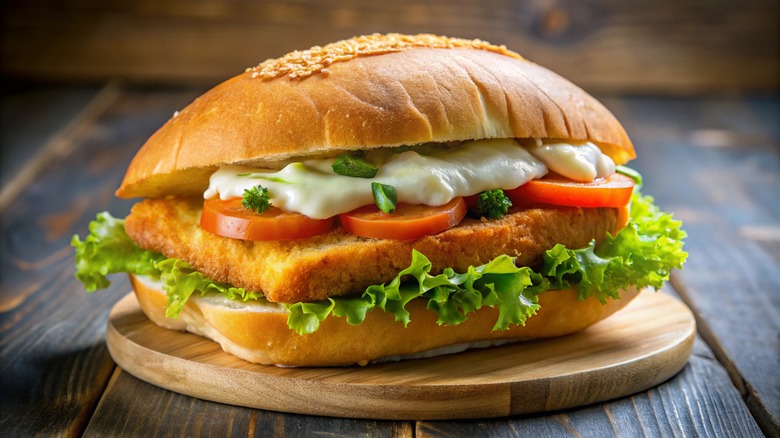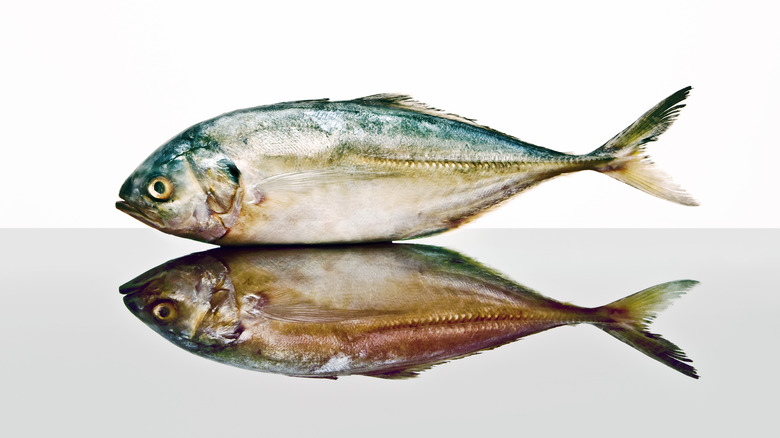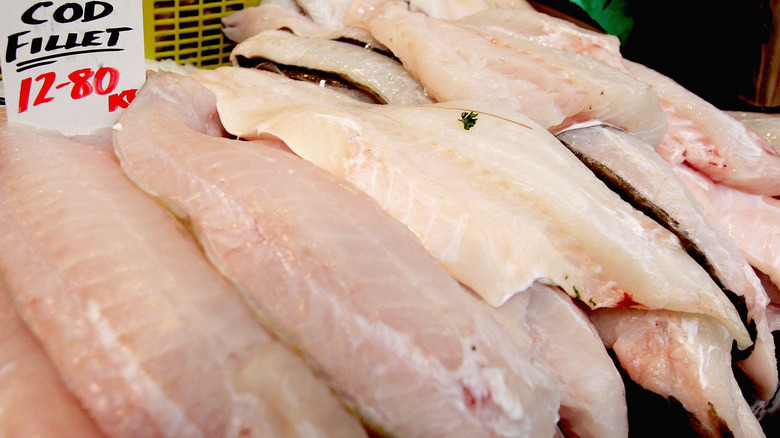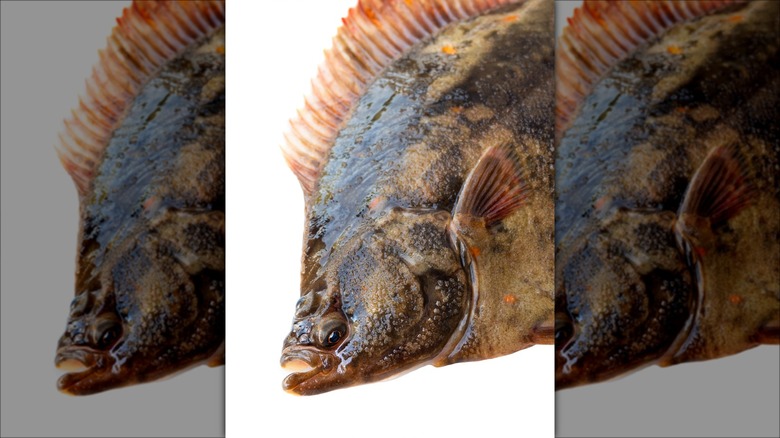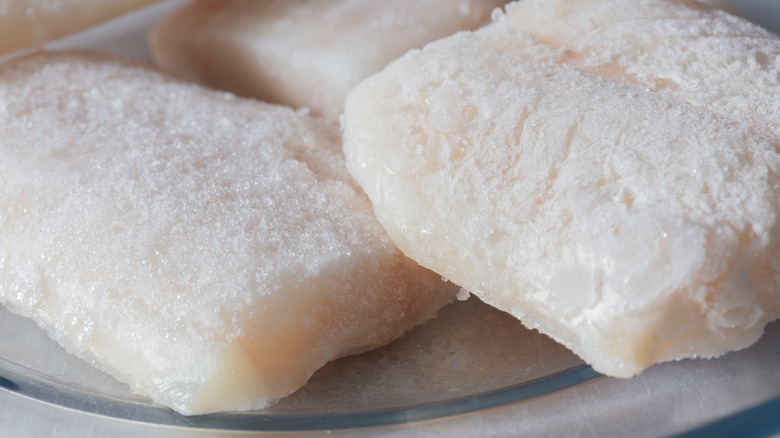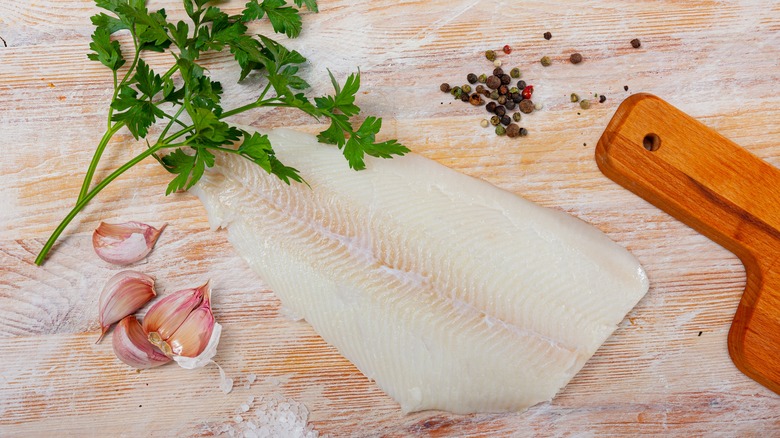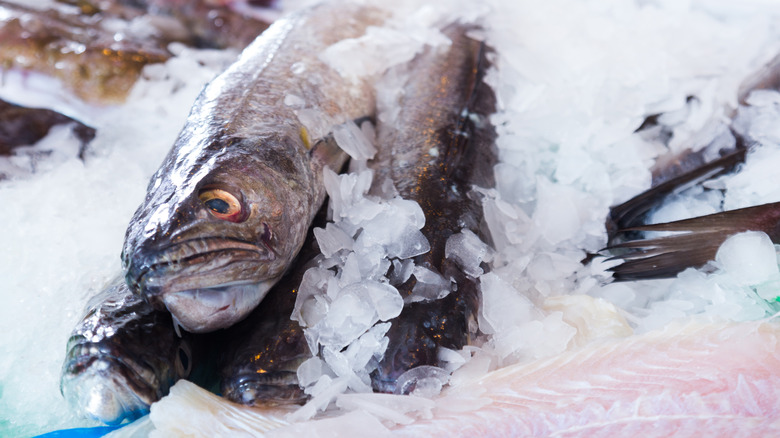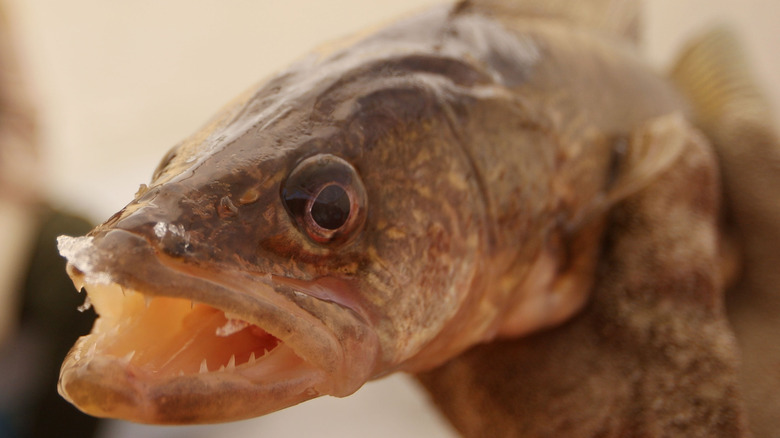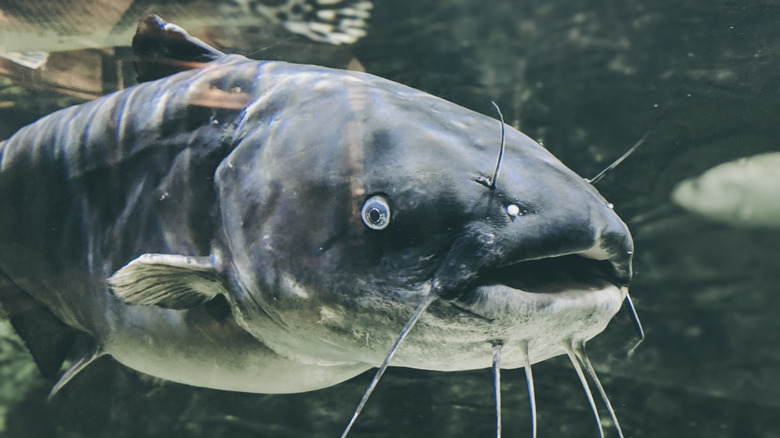8 Types Of Fish Fast Food Chains Use In Their Sandwiches
If you order a chicken sandwich or a burger at a fast food outlet, you can be pretty confident about what kind of meat you're biting into. But when you order a fish sandwich? Not so much. While some fast food restaurants are fairly transparent about their seafood, some are a bit more vague about the kind of catch used in their respective fish offerings.
As a general rule, you shouldn't expect this mystery fish to be the costliest catch. The fast food industry famously produces menu items as cheaply and efficiently as possible, meaning the fish in your sandwich is almost definitely a species that is both affordable and easy to source in bulk in the United States (which rules out the possibility of ordering the likes of black cod or bluefin tuna on your next trip through the drive thru). However, not every chain opts for the same catch when crafting your order. From McDonald's iconic Filet-O-Fish to the Popeyes Flounder Fish Sandwich, here are the kinds of fish that fast food restaurants actually use in their sandwiches.
1. Pollock
If one fish rules the fast food kingdom, it's pollock. To be specific, it's usually Alaskan pollock, with McDonald's famously using it to power its Filet-O-Fish for decades. Other fast food chains relying on pollock include Hardee's (or Carl's Jr., depending where you are) for its Panko Breaded Fish Sandwich, Wendy's for its Crispy Panko Fish Sandwich, Bojangle's for its Bojangler Fish Sandwich, Long John Silver's for its Fish Sandwich, and Whataburger with its iconic Whatacatch. That's a heck of a lot of pollock.
There's a reason why the humble pollock is so popular. For one thing, it's cheap. As GAPP CEO Craig Morris previously told Seafood Source, it's also the only wild-caught, sustainable, and mild-tasting fish that's readily available in the United States on such a large scale. Customers are allegedly also much more likely to buy seafood items that are described as being farmed in Alaska than other locations, as ASMI Domestic marketing manager Leah Krafft also noted. And it doesn't hurt that, even by fish standards, it's considered super healthy. High in protein and low in saturated fat, it makes a decent addition to any diet — if we temporarily ignore the deep frying that usually happens between being caught and being served up at fast food restaurants, that is.
2. Cod
While it may not be quite as omnipresent as pollock in the industry, you can still find a decent amount of cod in fast food restaurants — especially during Lent, when many chains introduce a fish alternative for those fasting on Fridays. For example, in case you hadn't already guessed from the name, Culver's uses cod in its North Atlantic Cod Sandwich. Burger chain Frisch's Big Boy Fish Sandwich also uses cod come Lent.
There was a time when cod was much more common in the industry, with Wendy's once also using it in its now-discontinued Cod Sandwich. (Of course, this was replaced by its pollock successor in 2021, but diehard cod lovers can feel vindicated knowing that this sandwich actually placed last in our ranking of fast food fish sandwiches). However, it's become much more expensive in recent years as Atlantic populations have plummeted due to overfishing in the late 20th century. In 2008, a study in Canadian Journal of Fisheries and Aquatic Sciences notes that it may be impossible for these populations to ever rebound. This seems to be true considering the fact that in 2022, more than a decade later, Atlantic cod hauls reached a new low. While imports from Iceland are still pretty common, the scarcity and efforts of sourcing cod mean it's an increasingly rare catch in the fast food biz.
3. Flounder
It shouldn't come as too much of a surprise that the Popeyes Flounder Fish Sandwich is made with, well, flounder. Alaskan flounder, to be precise. Known for its mild taste with a slight sweetness, flounder is delicious (if you don't believe us, we'll see you at Popeyes come Lent) but, with the exception of Popeyes, is actually a relatively rare find in the fast food industry.
Considering how versatile flounder is, it does seem strange that this is the case. Flounder is famously easy to cook in multiple different ways, and has garnered Popeyes rave reviews for the taste of its Flounder Fish Sandwich — to the extent that customers frequently petition for the chain to make it a year-round staple. We gave Popeyes Flounder Fish Sandwich a glowing review, praising "the crispy breading [that] gave way to white, flaky flounder that was flavorful without taking on the generic fishy quality of a lot of drive-thru code."
With so much love for catfish flavor (post deep-frying, at least) we have to assume that it's the price holding flounder from a bigger role in fast food. Reports from 2021 suggest that the price has increased in recent years. On average, flounder tends to come with a higher price tag per pound than the likes of pollock — which is most likely why the latter dominates fast food menus and flounder is a rare treat.
4. Haddock
Like most fish used in fast food fish sandwiches, haddock is a white fish with a very subtle flavor. It's an extremely popular choice of fish for restaurants and consumers in general, but some would say it's become too popular for its own good. The Atlantic haddock is notoriously overfished, with regulators slashing catch quotas by over 80% in May 2023 due to fears that the current rate was far too aggressive to sustainably support the haddock population in the long run. This followed another huge dip in the haddock population in the late 1990s, which sparked efforts to gradually rebuild the species' numbers.
Given the turbulence and instability of haddock fishing, it should come as no surprise that there isn't a huge number of eateries using haddock for their sandwiches. One exception is Portillo's. The Chicago street food chain uses breaded, wild-caught haddock in its Breaded Whitefish Sandwich. This has drawn some pretty divisive reviews from customers. As one Reddit user so eloquently put it, "Portillo's could do something so much better than a Filet-O-Fish copycat," with many mourning the days when it instead used halibut for its sandwich. With that in mind, maybe it's not the worst thing in the world that there aren't many fast food haddock sandwiches out there.
5. Halibut
Speaking of halibut, Portillo's isn't the only chain to choose the white fish for its sandwich at some point. Back in the day, before pollock became its go-to catch, McDonald's founder Ray Kroc wanted to use halibut for its Filet-O-Fish, as per his autobiography "Grinding It Out: The Making of McDonald's." But in the end, cod was cheaper.
And today, halibut is very expensive. The mild white fish – particularly its Atlantic variety — has become increasingly overfished. Halibut in general nearly doubled in price between 2020 and 2021 (aka before and after the COVID-19 pandemic hit), something Bloomberg notes was due to factors such as fishermen shortages. That doesn't mean it's totally absent from the fast food scene, though. Utah-based fast food chain Apollo Burger still uses halibut in its Fish Sandwich, making it one of the few (if not the only) chain to regularly feature the fish in its sandwiches right now.
6. Hoki
Hoki is another white fish that's occasionally used by fast food restaurants. The vast majority of any hoki consumed in the United States is imported from New Zealand, with the fish also found in southern Australia or off the coasts of South America. It's pretty similar to cod and pollock — which is probably why the fish is mixed in with the latter to make the Filet-O-Fish in New Zealand.
Despite its similarities to other popular species, this lack of local availability means hoki isn't used too often in the U.S. There have been concerns about the depletion of hoki populations in the Pacific. While New Zealand has imposed strict fishing limits, only allowing 10% of the total adult population of hoki to be caught per year, there have been reports of some of its most notable fishing companies underreporting their catches.
An even more pressing reason why you may find hoki in international fast food chains but not the U.S. is the fact that, back in 2022, the U.S. implemented an import ban on New Zealand hoki — plus eight other species — in an effort to protect the critically endangered Māui dolphin from fisheries. This ban was lifted in April 2024, opening the door for hoki to pop up on fast food menus at some point in the future (but considering the abundant, affordable availability of other fish, we still have our doubts).
7. Walleye
These toothy freshwater fish are renowned for their mild flavor, but have been used sparingly for fast food fish sandwiches in the past. The best known use of walleye is in the Culver's Northwoods Walleye Fish Sandwich, which featured a hand-battered fish filet during Lent. It hasn't popped up since the 2023 Lenten season, and while Culver's hasn't explained its disappearance, we think we can make a few educated guesses as to why.
Unsurprisingly, everything comes back to money. Walleye has proven difficult to farm in the past, with both its mortality rates and production costs coming up pretty high. As per the North Central Regional Aquaculture Center, it's considered a "high value species" due to its "popularity and limited supply." Most critically, the commercial fishing of walleye is actually banned in the United States to try and protect the ecosystems of its lakes and rivers. Instead, anywhere wanting to sell walleye needs to secure their fish from Canada, just like Culver's did until the Northwoods Walleye Fish Sandwich's apparent retirement.
8. Catfish
Catfish aren't the prettiest fish, but they definitely deliver on the flavor front — especially when fried. That's why so many people were passionate (and we mean extremely passionate) about the Popeyes Catfish Po'Boy, with some criticizing the chain's decision to ultimately switch this fish offering out for flounder. Farm Burger also waded into the catfish community by introducing its blue catfish burger in 2019, when it was partially launched to help offset the ecological issues caused by Chesapeake Bay's soaring catfish population.
While we'd love to see more restaurants embrace catfish in this way (or see Popeyes bring back the Catfish Po'Boy), we don't want to set our hopes too high. The good news is that catfish isn't an overfished species. In fact, the catfish in Virginia's aforementioned Chesapeake Bay are considered to be an invasive species. Catfish is also famously cheaper than a lot of its rivals, with some even dubbing it "the poor man's fish," as noted by the Heartland Catfish Company – and so it's surprising that more restaurants don't feature catfish on their menus. One of life's many mysteries.
